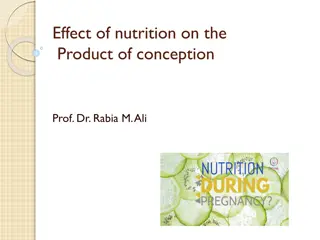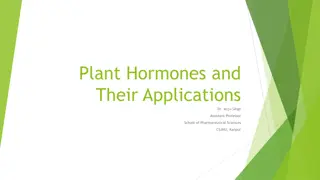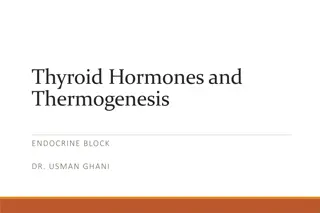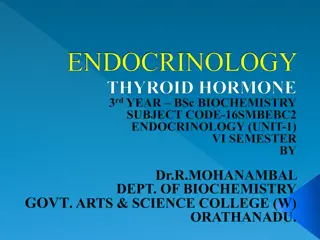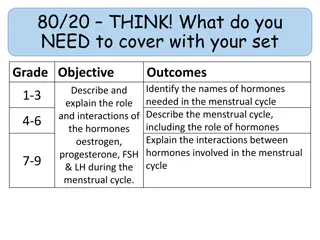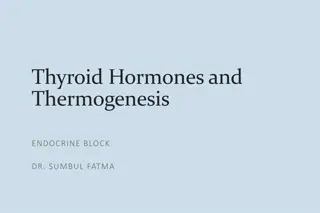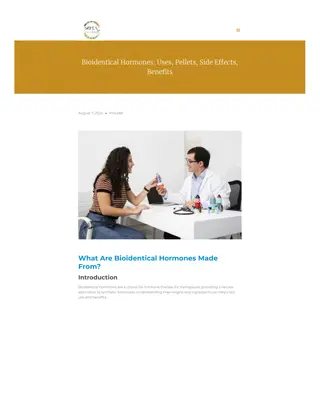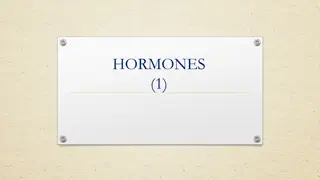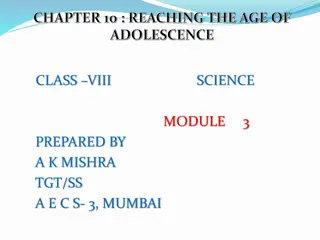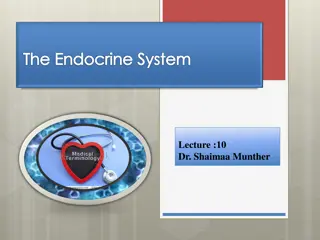Endocrinological Aspects of Pregnancy: Hormones, Functions, and Synthesis
During pregnancy, endocrinological structures like the corpus luteum and placenta play vital roles in the production of hormones such as progesterone and estrogens. Progesterone maintains pregnancy by controlling essential functions like endometrial differentiation, myometrial quiescence, and local immunotolerance in the uterus. Placental estrogens, specifically estradiol-17, are important in various species, with unique synthesis processes observed, such as in bovines and equines. Understanding the roles and synthesis of these hormones is crucial for the successful progression of pregnancy.
Download Presentation

Please find below an Image/Link to download the presentation.
The content on the website is provided AS IS for your information and personal use only. It may not be sold, licensed, or shared on other websites without obtaining consent from the author. Download presentation by click this link. If you encounter any issues during the download, it is possible that the publisher has removed the file from their server.
E N D
Presentation Transcript
Lecture 03 Applied endocrinology of pregnancy
Endocrinological structures during pregnancy Carpus luteum Placenta Both structures act as temporary endocrine organ. Perform steroidogenic activity Steroidogenic activity of placenta is observed in majority of mammals except DOG 2
Hormones of pregnancy 1. Progesterone Mare and Ewe derives their progesterone from placenta at later half of pregnancy Principal hormone for pregnancy known as luteo luteo- -placental shift placental shift maintenance During initial stage of pregnancy, functional CL releases progesterone Serum progesterone level remains constant throughout pregnancy in cow CL persist throughout pregnancy in all species and ewe but in Sow, its high level is except in mare observed during early stage of pregnancy Cow, Doe and Sow primary source of progesterone is CL 3
Role of progesterone during pregnancy It controls various essential functions during gestation period Endometrial differentiation Myometrial quiescence Closure of the cervix Local immunotolerance in the pregnant uterus 4
2. Placental estrogens Estradiol-17 is the most relevant form of estrogen found in dam blood In sheep and cattle Estrone and sulphonated form of estrogen remains high during gestation period Ruminanats and camelids, the maternal estrogen rises at uniform rate Sudden peak of estrogen during mid gestation is physiological in Equines Species specific placental estrogens in equines is termed as equilin and equilenin 5
Placental synthesis of estrogens Bovine placenta synthesizes estrogen from cholesterol (precursor) Equine placentae can not synthesize estrogen like bovine, due to its dependency on fetal gonads for C19precursor Steroidogenesis associated with pregnancy in horse is a dependent process involving placenta and fetus which led to the terminology - feto-placental unit 6
Functions of placental estrogens Ruminants including the role of placental estrogens Preparation of the birth canal for Maternal estrogen levels start to increase significantly between days 120-150. parturition Myometrial excitability at advance stage Mammary gland development during late In ruminants sulphonated estrogen level remains higher throughout pregnancy exept immediate pre or intrapartal period gestation 7
Androgens C19steroids Androstenedione Dehydroepiandrosterone (DHEA) Sulfonated DHEA (DHEAS) C19 precursors synthesis androgens steroids act as for the of bioactive C19steroids serves as precursor for placental estrogen synthesis in equines 8
Pregnancy-associated prolactin and growth hormones In rodents and ruminants these substances named as Placental lactogen (PL) PRL-like proteins (PLPs) PRL-related proteins (PRPs) Proliferin (PLF). Functions In ruminants associated with Development of uterus and mammary gland Transport of nutrients from the dam to the fetal compartment 9
Relaxin/insulin-like family peptides Commonly denoted by RLNs Source of RLNs Placenta Horse, cat, dog, rabbit and camel Carpus luteum Pig and rodents . 10
RLNs functions uterine and vaginal growth Development of the mammary gland and/or nipples Function of RLNs are different in various species Decidualization Immunomodulation Quiescence of the myometrium Maternal circulatory adaptations of pregnancy Stimulation of angiogenesis During prepartal period Relaxation of the pubic ligament Preparation of the vaginal canal for parturition. 11
Endocrinology of pregnancy in mare A different species to deal with
Maintenance of progesterone concentration during pregnancy Early stage of pregnancy, Primary corpus luteum secrets progesterone followed by secondary carpora lutea Post day 150 matured placenta takes up secretion of progesterone sufficient for physiological need of pregnancy, phenomena is termed as luteo-placental shift Estrogen during pregnancy Plasma estrogen concentration remains low during first trimester, gradually increases to peak between 9thto 11thmonth, thereafter declines near foaling 13 Courtesy - Kritika s drawing
Endocrinology of pregnancy in mare Hormones source Days of pregnancy Primary corpus luteum 01 - 35 Secondary carpora lutea 36 - 150 Progesteroe Placenta 151 till foaling Equine chorionic Gonadotropin Endometrial cups 36 - 140 Estrogen Placenta 100 - 330 14
Thanks! Any questions? You can find me at: alok9alright@gmail.com Dr Alok Kumar Assistant Professor cum jr. Scientist Veterinary Gynaecology and Obstetrics Bihar Veterinary College, BASU. Patna 15




